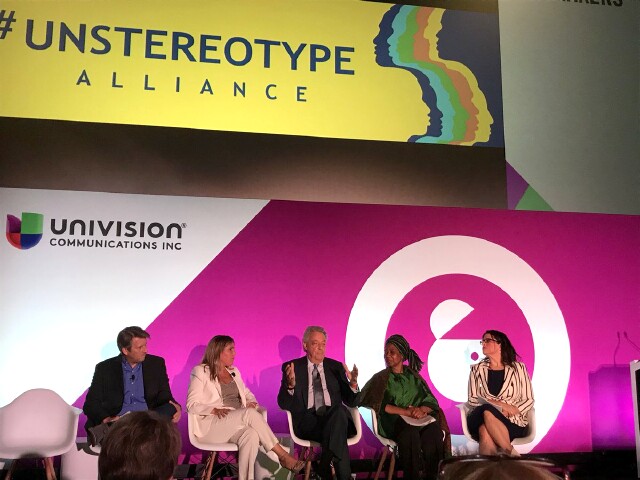Diversity and Inclusion: “It’s Everything and Every Thing”

Diversity and Inclusion (D&I) remains a hot button for the advertising industry. It has become a business imperative due to a convergence of societal, political, cultural, economic, technological and demographic changes in the United States and the world. There is a relevance imperative prompted by research findings revealing that by 2050 there will be no racial or ethnic majority in the U.S. as historically under-represented groups become the majority. There is an economic imperative as many individual companies report that diversity increases creative relevance, informs better decisions, increases product sales and enhances economic growth. There is an industry vitality imperative as media and advertising ranks last for key diversity and inclusion performance metrics when compared to 15 leading industries. And, finally, there is a human imperative for societies to thrive. Throughout Advertising Week New York, corporate leaders were quick to highlight their commitment to D&I and to discuss actions that they are taking to make a difference.
The definition of diversity is inherently broad. Historically, most organizations would “pick a lane” and focus on gender or race. Throughout the week, I was struck by the multi-dimensional nature of conversations. CEOs and thought leaders openly discussed the importance of intersectionality including diversity of thought, culture, religion, capability, socio-economic background, gender identity, sexual orientation, language, cognitive style, demographics and other visible and invisible attributes. There was a deep understanding that D&I as a business strategy is fundamentally complex.
To help expedite industry change, several organizations and associations are dedicated to collaboration amongst competitors. Two of these leading organizations are CEO Action and the Unstereotype Alliance. Both serve as resource centers for competitors to share research, best practices and new insights related to D&I and each hosted a panel during Advertising Week. It’s interesting to note that IPG, Unilever and OMD are members of both organizations.
Michael Roth, Chairman and Chief Executive Officer, Interpublic Group is personally a member of both. “Tokenism must be addressed to achieve the next level of inclusivity,” he declared. “Representation must go beyond the ‘checked box’ to include diverse people along with diverse voices and social beliefs.” To illustrate this, he played The Problem is Not Seeing the Problem, a short video produced by IPG on behalf of the Unstereotype Alliance, calling on the industry to act immediately to eliminate gender and other intersecting stereotypes from their ads.
Aline Santos, Executive Vice President, Global Marketing, Unilever echoed the sentiment. She urged colleagues and competitors to “stop being so lazy” in addressing harmful stereotypes and provided evidence that authentic portrayals work. “Unilever reaches 2.5 billion people daily and the company has seen amazing results including 25% more branded impact and 21% more purchase intention and more credibility with consumers,” she said. While stereotypes are the easy, quick way to communicate (almost a shorthand), she cautioned that “if people don’t see themselves in advertisements, the lack of relevance and relatability will kill the brand and ultimately humanity.”
Corporate leaders across panels agreed that the tone from the top must be very clear; it must articulate that D&I is a company-wide position for the organization impacting talent, client retention and profitability. John Osborn, Chief Executive Officer, OMD and part of the Omnicom Media Group believes that D&I has to be “intentional.” He added that, “it’s not just top down or a bottom up; it’s everything and every thing. OMD has a diversity committee and Osborn shared that “everyone has a voice, everyone belongs.”
While the collective power and sharing of best practices are working for companies with that deep commitment to seeing the change in their work and within their workforce, the greatest risks of D&I are thought to be an inability to respond in real time, complacency and recognition that D&I is a long-term proposition.
It was uplifting to see how a select group of companies including IPG, OMD, Unilever, P&G, AT&T, Publicis Groupe, Diageo and Verizon have made bold commitments to advancing the full spectrum of D&I initiatives within their organizations. However, it was also a bit disheartening to recognize that the majority of companies are absent from the dialogue. This silence prompts the question of whether they are prioritizing D&I within their organizations at all and/or simply choosing to keep their journey quiet for now. In either case, time will tell.
Pictured at top, left to right: Bill Moseley, Director, Marketing Communications, AT&T; Aline Santos Farhat, Executive Vice President, Global Marketing, Unilever; Michael Roth, Chairman and CEO, Interpublic Group; Phumzile Mlambo-Ngcuka, Executive Director, UN Women, and Jess Weiner, Business Strategist and Cultural Changemaker, Talk to Jess.
Click the social buttons above or below to share this content with your friends and colleagues.
The opinions and points of view expressed in this content are exclusively the views of the author and/or subject(s) and do not necessarily represent the views of MediaVillage.com/MyersBizNet, Inc. management or associated writers.


